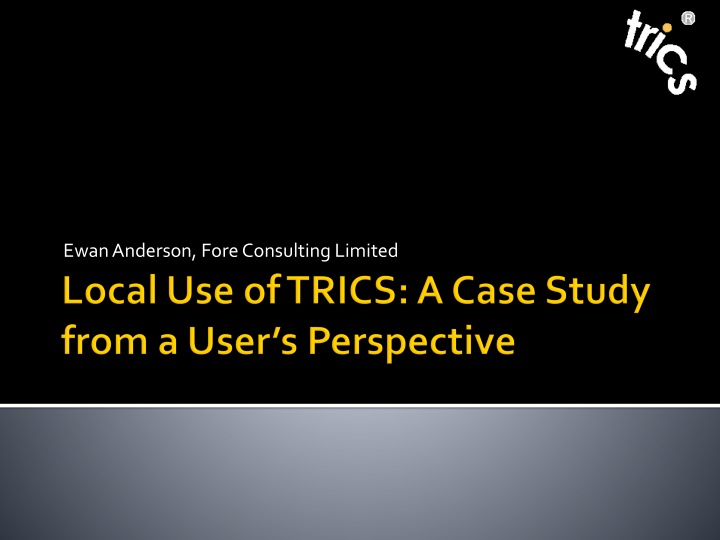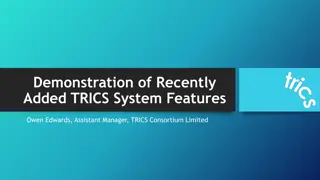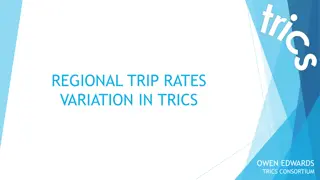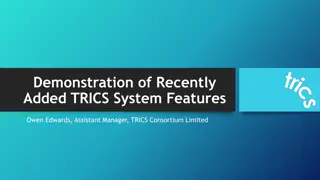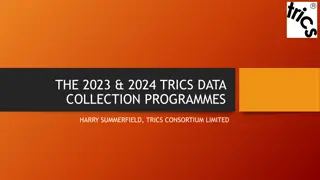TRICS Analysis for Large-Scale Development Projects
Ewan Anderson from Fore Consulting Limited discusses the application of TRICS in evaluating transportation impacts for large strategic sites like Harlow Grange and Clifton Gate. TRICS is used to estimate average person trip rates and vehicular trip rates, providing valuable insights for traffic planning and management. The analysis showcases how TRICS effectively handles projects of this scale, offering tailored search criteria and options for matching proposed developments.
Download Presentation

Please find below an Image/Link to download the presentation.
The content on the website is provided AS IS for your information and personal use only. It may not be sold, licensed, or shared on other websites without obtaining consent from the author.If you encounter any issues during the download, it is possible that the publisher has removed the file from their server.
You are allowed to download the files provided on this website for personal or commercial use, subject to the condition that they are used lawfully. All files are the property of their respective owners.
The content on the website is provided AS IS for your information and personal use only. It may not be sold, licensed, or shared on other websites without obtaining consent from the author.
E N D
Presentation Transcript
Two examples of recent projects: Harlow Grange, Harrogate (124 dwellings). Clifton Gate, York (3,400 dwellings). Look at where TRICS works well and where it is currently limited. Is TRICS appropriate when working on large/strategic sites? Some questions for TRICS (and users) going forward.
Proposed development of 124 residential dwellings. Approximately 3.0km southwest of Harrogate Town Centre. Immediately north of B6162Otley Road.
TRICS used to derive average person trip rates (Multi- Modal Total People ) for the proposed development. Database interrogated for sites based on the following criteria: 03 Residential A Houses Privately Owned Edge of Town Number of dwellings 93 to 155 Dwellings (ie +/-25% of the proposed development) 98 to 155 Dwellings Monday to Friday No 1 Dwelling Land Use Category Location Trip Rate Parameter Range Selected by User Actual Range Survey Days Travel Plan Calculation Factor
Estimation of vehicular trip rates: Person trip rates from TRICS applied to the car driver mode share for the local ward. Harlow Moor ward ( Method of Travel to Work , 2011 Census) = 64%. Trip Rates (Vehicles/per unit) Land Use Unit Weekday AM Peak Hour Weekday PM Peak Hour Arrivals Departures Arrivals Departures Residential 1 Dwelling 0.146 0.521 0.391 0.221 TRICS is considered to work well for projects of this type. Large number of similar sites available. Options to tailor search criteria to match proposed development.
Located: North of the A1237 Outer Ring Road at Clifton Moor. Approximately 5.0km northwest of York City Centre. 140 hectares of land.
Proposed development of 3,400 residential dwellings. A draft allocation in the City of York Local Plan. Sustainable new settlement, including: Local facilities. Social infrastructure. Convenience retail. Park & Ride and regular bus service to city centre.
Used the same approach to deriving person trips rates as for the previous example. Provides similar search criteria: Residential, Houses Privately Owned, Edge of Town, etc. However, very few large residential sites within TRICS database. Comparison of vehicular trip rates between the two projects: Trip Rates (Vehicles/per unit) Project Weekday AM Peak Hour Weekday PM Peak Hour Arrivals Departures Total Arrivals Departures Total HarlowGrange 0.146 0.521 0.667 0.391 0.221 0.612 Clifton Gate 0.181 0.534 0.715 0.384 0.243 0.627
Origin-Destination Survey of proxy area. ANPR cameras covered all vehicle routes into Haxby and Wigginton. Excluded through traffic movements. Counted all residential dwellings. Site (Red) Proxy (Blue)
Does the use of TRICS accurately provide trip rates for large/strategic developments, at present? If not, can TRICS respond to this challenge moving forward, or do we need to adopt a different approach to deriving trip rates for these sites? For example, by desegregating trips by journey purpose.
Increasingly working on more large-scale, strategic sites. Brought about by changes to the national policy framework. Changes to planning policy through NPPF. DfTCircular 02/2013 Sites being promoted through the Local Plan process. If not, does the use of TRICS become a barrier to development? Overestimating the traffic generation and traffic impact on the highway network. Extent of study area to be assessed. Mitigation schemes required.
Does TRICS need to expand its database to include more large/strategic sites? If so, how feasible is the collection of accurate data for these sites? The internalisation of trips. Multi-modal trip rates. Phasing and build-out (10- years). And how can these sites be integrated into TRICS?
